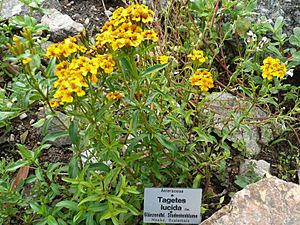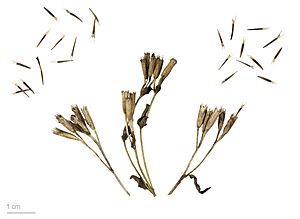Sweetscented marigold facts for kids
Quick facts for kids Sweetscented marigold |
|
|---|---|
 |
|
| Botanischer Garten Erlangen, Germany | |
| Scientific classification | |
| Genus: |
Tagetes
|
| Species: |
lucida
|
| Synonyms | |
|
|
Tagetes lucida is a plant that grows year after year, meaning it's a perennial plant. It comes from Mexico and Central America. People use it as a medicinal plant and also as a cooking herb.
The leaves of Tagetes lucida smell a bit like tarragon, with a hint of anise. Because of this, it's often sold in plant nurseries as a good substitute for tarragon. Some common names for this plant include sweetscented marigold, Mexican marigold, Mexican mint marigold, Mexican tarragon, sweet mace, Texas tarragon, pericón, yerbaniz, and hierbanís.
What Mexican Mint Marigold Looks Like
Tagetes lucida usually grows about 45–75 cm (18–30 in) tall. It needs lots of sunshine or just a little bit of shade to grow well. Some types of this plant grow straight up, while others are bushy with many stems.
The leaves are long and narrow, about 7.5 cm (3 in) in length. They are a shiny medium green color, not the blue-green you might see on French tarragon. In late summer, the plant produces groups of small, golden-yellow flowers at the ends of its stems. These flower heads are about 15 mm (1⁄2 in) wide. Each flower head has 3 to 5 golden-yellow ray florets, which look like petals. The flowers have both male and female parts, and insects help them make seeds.
How People Use This Plant
Long ago, the Aztecs used Tagetes lucida in special ceremonies. They burned it as a type of incense called Yauhtli. They also believed it was connected to their rain god, Tlāloc. Even today, people still use Tagetes lucida to make a tea. This tea is often used to help with common colds, tummy gas, and diarrhea.
Archaeologists have found that the Maya also used Tagetes lucida. They would mix it with tobacco.
The Aztecs also used Tagetes lucida in their cooking. It was one of the ingredients they added to a special drink called chocolatl, which gave it a spicy taste. Today, you can use the fresh or dried leaves as a substitute for tarragon. It's great for adding flavor to soups and sauces. You can also brew a tasty tea with a hint of anise flavor using the dried leaves and flowers. This tea is mostly used for traditional medicine in Mexico and Central America.
Besides food and medicine, the flowers of Tagetes lucida can be used to make a yellow dye. When the plant is dried and burned, it can also be used as an incense or to help keep insects away.
See also
 In Spanish: Pericón para niños
In Spanish: Pericón para niños


